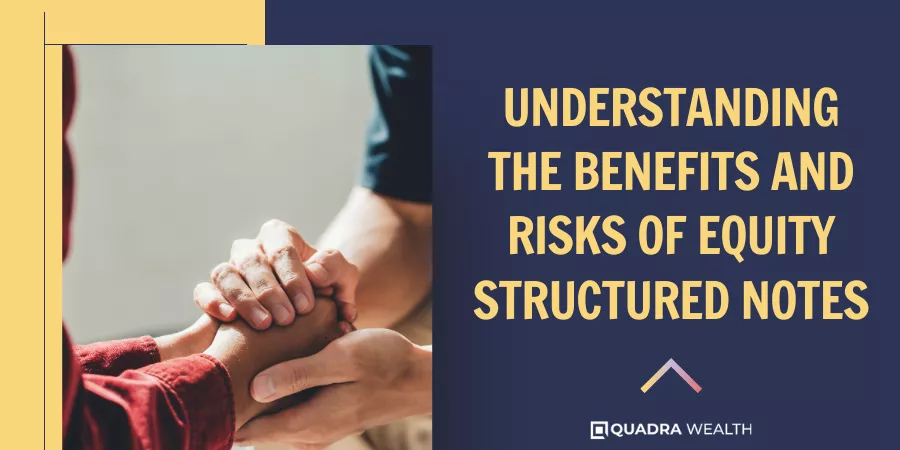Have you ever wondered how to boost your investment portfolio’s potential while reducing risk? Structured notes are an intriguing financial instrument that blends bonds and derivatives.
This guide will shed light on a specific type: equity structured notes and help weigh their pros and cons, along with effective methods for investing in them. Ready to unwrap the mystery of this complex but potentially rewarding addition to your financial toolkit? Let’s dive right in!
Key takeaways
● Equity-structured notes are bonds tied to other assets. They earn money from stock market changes and help spread out risk.
● High returns, downside protection, customization, and complex strategies are some benefits of equity-structured notes.
● These notes also have risks like credit risk, chance of missed payments, high fees, and limited liquidity.
● Buying them involves careful steps. It starts with knowing your goal to keep track of price performance after buying the note.
What Are Equity Structured Notes?
Equity-structured notes are special types of bonds. They come from big banks. These notes tie to other assets like stocks or market indexes like the S&P 500 Index. The value of these notes can go up and down based on these tied assets.
Banks make use of debt obligations and a part called a derivative portion in making equity-structured notes. This mix allows buyers to earn money from changes in the stock market. But it’s not just about earning more money.
Equity-structured note also offers ways to spread out risk-taking over many kinds of investments such as stocks, bonds, commodities, and currencies.
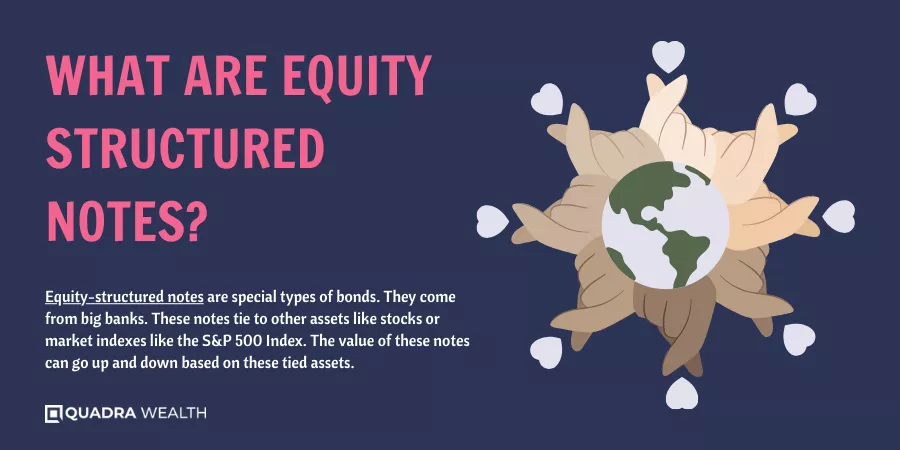
Advantages of Equity Structured Notes
Net worth is your total wealth. It is the sum of everything you own minus what you owe. A high net worth means good financial health. This tells if you should save more or cut costs for retirement.
Checking your net worth also helps to choose how to invest money wisely. Events like getting married, having a baby or almost retiring mean that you must look at your net worth carefully as it can affect them all.

Analyzing Your Earnings and Expenditure
Equity Structured Notes offer potential high returns, correlating to the performance of an underlying asset like a stock. They provide excellent downside protection through embedded derivative components that shield you from adverse market movements.
Customization enables retail investors to tailor these financial products according to their risk/reward equations and investment objectives. Moreover, these tools facilitate complex investment strategies by offering indirect exposure to multiple markets or blue-chip stocks without actual ownership or time-consuming purchasing processes.
High Potential Returns
You can make a lot of money with equity-structured notes. These offer high returns to those who invest. Strong stock market performance boosts the return on these notes. They mix fixed income and gain from underlying assets.
This way, you keep earning even when the markets are not doing well.
One special type is called Principal-Protected Notes (PPNs). They give back your initial investment plus any gains that occur. Hence, they can earn a high payout while keeping their capital safe at the same time.
Above all, always be ready for risks along with high potential returns in trading such financial instruments.
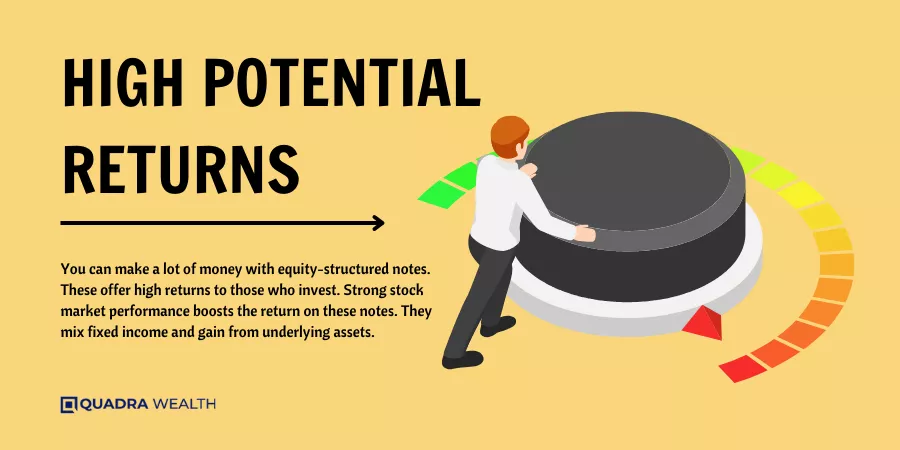
Downside Protection
You can have less fear of losing money with equity-structured notes. This is because of downside protection. It keeps your cash safe when stock prices fall. A note called “Principal-Protected Note” lets you get your first cash back, even if the stock price goes down.
So, you could enjoy gains from stocks and still keep your money safe during hard times in the market.

Customization
You can shape structured notes to match your money goals. For example, if you want more income, growth, or protection. Halo’s note maker lets you design a note for these aims. This may include income notes and growth notes.
Also, there are options like absolute notes, digital notes, and principal-protected notes (PPN).
Facilitates Complex Investment Strategies
Equity-structured notes are useful in complex investment plans. They let you link to many asset classes like stocks, bonds, commodities, and foreign currencies. With the debt component and derivative element mixed, they can follow market indexes like the S&P 500 Index or S&P Emerging Markets Core Index.
This helps you spread your risk out more widely than with just one type of asset. Thinking about investing tools this way opens up new ways to play strategies that normal financial products can’t do as well — all in one neat package! You get exposure from different points of view without needing to buy each part by itself.
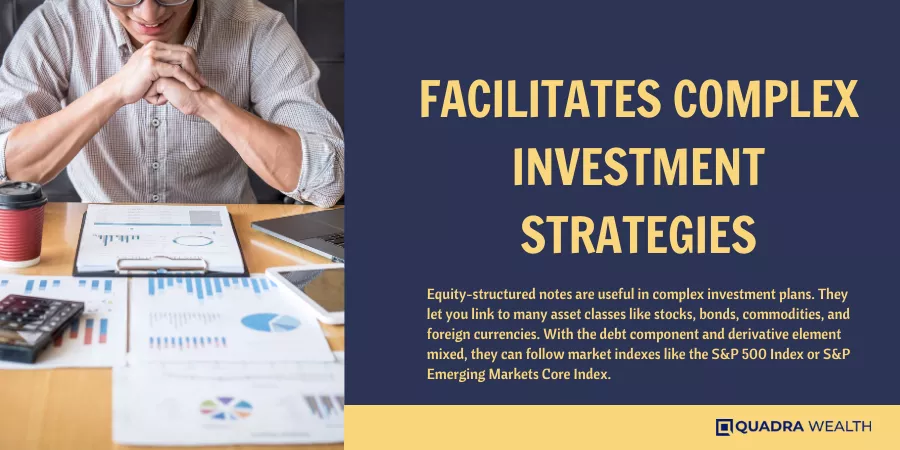
Disadvantages of Equity Structured Notes
Investing in Equity Structured Notes is not without risks, including the burdensome credit risk associated with the note’s issuer. Unpredictable market conditions may lead to a chance of missed payments, impacting the reliable income stream you have in mind.
While structured notes may seem appealing at first sight, sophisticated investors need to account for potentially high fees that could significantly slice off their investment returns. Additionally, it’s vital to acknowledge these financial instruments’ limited liquidity – this means your access to your capital might not be as fluid or efficient as other traditional investments.
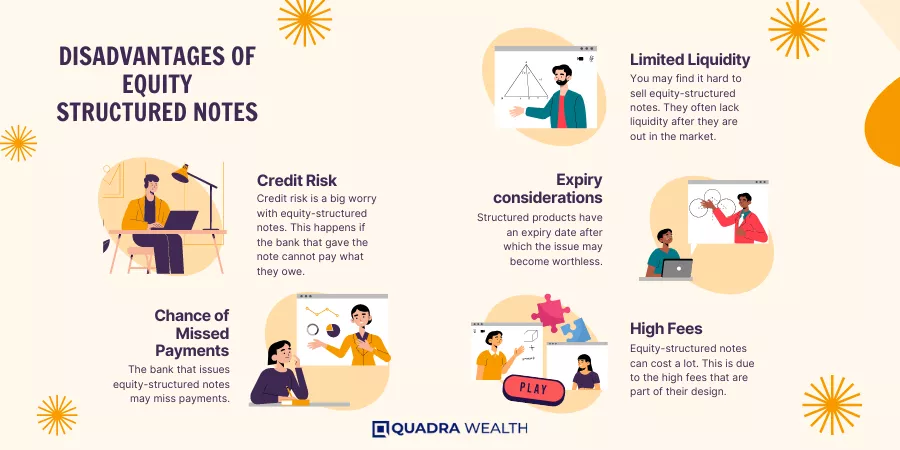
Credit Risk
Credit risk is a big worry with equity-structured notes. This happens if the bank that gave the note cannot pay what they owe. For example, if you buy a note and the bank fails, your money can be lost as these notes are unsecured loans.
Even notes that promise to keep your starting money safe have this risk. The trustworthiness of the bank matters a lot in knowing how much credit risk there is when buying these notes.
So, it’s key to pick sound banks for getting equity-structured notes!
Chance of Missed Payments
The bank that issues equity-structured notes may miss payments. This happens if the bank cannot meet its debt obligations. So not all principal invested might be returned which could result in a loss.
It happened when Lehman Brothers couldn’t pay back its debts, and it can happen again. Therefore, always check the strength of your investment bank before you invest.

High Fees
Equity-structured notes can cost a lot. This is due to the high fees that are part of their design. These fees shrink the value of your original investment and so, you start at a loss right off the bat.
As average investors, this makes it harder for you to earn back your money. Even if you do make gains from market movements, these earnings are often not enough to cover these costs fully.
So be warned – don’t ignore those hidden high fees!
Limited Liquidity
You may find it hard to sell equity-structured notes. They often lack liquidity after they are out in the market. The chance to trade them on a secondary market is small. This means you can’t get your money if you need it fast.
Pricing becomes unclear too, with no selling and buying all the time. There’s less trading of these notes, which leads to wrong prices sometimes. The price might not show its real value because of this limited liquidity.
Understanding the Risks
Equity structured notes, like all investments, come with their risks including lack of liquidity and inaccurate pricing; delve deeper to comprehend these hazards before venturing into this investment pathway.
Get ready to explore the often overlooked yet significant details like caps and dividends in the fine print that may impact your returns. Continue reading to arm yourself with the crucial knowledge necessary for informed decisions in your investment journey.

Lack of Liquidity
Equity-structured notes are not easy to sell. Once you buy them, they do not trade on a market where others can buy them from you. This is the lack of liquidity problem. It means you may find it hard to turn those notes into cash quickly if needed.
Their complex nature makes fewer people willing to buy them off your hands and this adds up to their tough sell status.
Inaccurate Pricing
Pricing structured notes can be tricky. This may lead to pricing errors. Structured notes don’t trade after they are sold. That adds to the chances of wrong prices. Wrong pricing might mean you pay more for a note than its real value.
Or you get less money when it’s time to cash in the note if the price is lower than face value. This can hurt how much money you make from these notes or even lead to losses.
Read the Fine Print on Caps and Dividends
There are many small details in the fine print of equity-structured notes. Here are four things to look for:
- A cap, or limit, is often put on the return you can make on the note.
- Some notes will not give you any dividends from the stocks they track.
- The rules for when and how much you get paid can be very tricky. You need to understand these before buying a note.
- If an investment bank fails, you may lose all your money. Your note is only as safe as the bank that offers it.
Investing in Equity Structured Notes
Choosing to invest in equity-structured notes requires careful consideration of your financial goals and risk tolerance. You can purchase these through investment banks or online broker platforms like Fidelity, Ameriprise Financial, or Yieldstreet.
These notes offer a way to diversify your portfolio by being linked to different asset classes such as stocks, bonds, commodities, or currencies. To successfully navigate this complex investment product, it’s critical you understand the associated risks such as the creditworthiness of the issuer and lack of liquidity.
Ensure you explore all tax implications before making an investment decision; individual retirement accounts (IRA), for example, could be affected differently. Always remember that while equity-structured notes may provide higher potential returns than traditional investments like mutual funds or ETFs, they come with their unique set of challenges and complexities which should not be overlooked.

How to Buy and Sell
Buying and selling equity structured notes need careful steps. Here’s how to do it:
- Know your goal in investing first.
- Study the stock market.
- Learn about structured notes and their risks.
- Find a good financial advisor or an online broker platform. These people can help you make wise decisions.
- Choose structured notes that fit your goals and risk level.
- Make sure to read all the details before you buy. You must know about fees, payouts, and risks.
- Start buying structured notes from banks or online platforms.
- Keep track of their price and performance.
- If ready, sell them on the second-hand market.
How Structured Notes Can Diversify Your Investment Portfolio
Structured notes add a fresh layer to your mix of assets. These notes link their returns to stocks, bonds, and other types of investments. You manage risk better when you spread money across various assets.
So putting some cash into structured notes protects it if one area does poorly. Money also grows in different ways with structured notes because they react differently to changes in the market than traditional investments like straight-up stocks or bonds.
This makes them a useful tool for adding variety to what you own and safeguarding your wealth over time against ups and downs in the economy’s health.
Conclusion
Structured notes can heighten your returns. They shield you from loss and suit many plans. However, they also bear risks like high costs and locked money. Therefore, take time to learn if structured notes work for you.
FAQs
Why invest in structured notes?
Structured notes often offer investors potential returns that are higher than interest rates offered on traditional deposits. They may even offer the potential for capital appreciation.
But such returns or capital gains are dependent on the performance of the underlying reference asset(s) or benchmark(s), which in turn exposes the investor to a greater variety of risks than a traditional deposit would
Equity structured notes mix bonds with options to invest in equity markets for that set time.
Yes, the market risk of a note’s asset and how the payoff structure works can affect an investment’s return. Also, you might lose money if financial institutions like RBC Capital Markets or J.P. Morgan Structured Products have problems.
All structured notes come with costs such as routine charges from banks or rare events like call feature use.
Fixed-income securities, Exchange-traded funds (ETFs), and Market index target-term securities (MITTS) diversify your investments reducing total loss risk from collapse similar to Lehman Brothers’ event.
Income Generation through equity-linked notes is usually counted as ordinary income by the U.S. Securities and Exchange Commission (SEC). This sometimes does not get the lower capital gains rate making it benefit less if placed in an individual retirement account (IRA).
Yes! The balanced portfolio needs Equities too along with Market Volatility which helps tender stretched valuations using alternative investments like real estate or private business credit.

